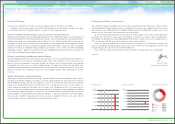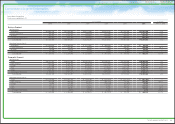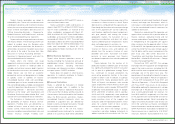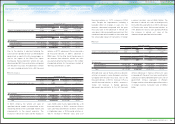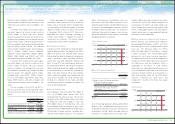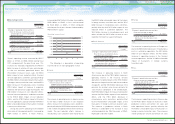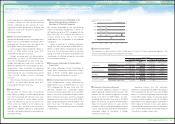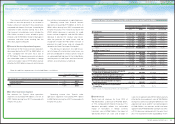Toyota 2011 Annual Report Download - page 46
Download and view the complete annual report
Please find page 46 of the 2011 Toyota annual report below. You can navigate through the pages in the report by either clicking on the pages listed below, or by using the keyword search tool below to find specific information within the annual report.
0822
Financial Section and
Investor Information
Business and
Performance Review
Special FeatureMessage/Vision
Management and
Corporate Information
Management's Discussion and Analysis of Financial Condition and Results of Operations
those hazardous materials and recyclable parts
are removed from vehicles prior to scrapping.
See “Legislation Regarding End-of-Life Vehicles”,
“Information on the Company — Business
Overview — Governmental Regulation, Environ-
mental and Safety Standards” and note 23 to the
consolidated financial statements for a more
detailed discussion of these laws, regulations and
policies.
Many governments also regulate local
content, impose tariffs and other trade barriers,
and enact price or exchange controls that can
limit an automaker’s operations and can make the
repatriation of profits unpredictable. Changes in
these laws, regulations, policies and other
governmental actions may affect the production,
licensing, distribution or sale of Toyota’s products,
cost of products or applicable tax rates. Toyota is
currently one of the defendants in purported
national class actions alleging violations of the
U.S. Sherman Antitrust Act. Toyota believes that
its actions have been lawful. In order to avoid a
protracted dispute, however, Toyota entered into
a settlement agreement with the plaintiffs at the
end of February 2006. The settlement agreement
is pending the approval of the federal district
court, and immediately upon approval the
plaintiffs will be required under the terms of the
settlement agreement to withdraw all pending
actions against Toyota in the federal district court
as well as all state courts and all related actions
will be closed. From time-to-time when potential
safety problems arise, Toyota issues vehicle
recalls and takes other safety measures including
safety campaigns with respect to its vehicles. In
November 2009, Toyota announced a safety
campaign in North America for certain models of
Toyota and Lexus brands’ vehicles related to floor
mat entrapment of accelerator pedals, and later
expanded it to include additional models. In
order to offer financial services in many countries.
Toyota’s competitors for retail financing and
retail leasing include commercial banks, credit
unions and other finance companies. Meanwhile,
commercial banks and other captive automobile
finance companies also compete against Toyota’s
wholesale financing activities.
Toyota’s financial assets decreased during
fiscal 2011 due to the unfavorable impact of
fluctuations in foreign currency translation rates.
The following table provides information regarding Toyota’s finance receivables and operating leases in
the past two fiscal years.
January 2010, Toyota announced a recall in North
America for certain models of Toyota vehicles
related to sticking and slow-to-return accelerator
pedals. Also in January 2010, Toyota recalled in
Europe and China certain models of Toyota
vehicles related to sticking accelerator pedals. In
February 2010, Toyota announced a recall in
markets including Japan, North America and
Europe related to the braking control system in
certain vehicle models including the Prius. The
recalls and other safety measures described
above have led to a number of claims, lawsuits
and government investigations against Toyota in
the United States. For a more detailed description
of these claims, lawsuits and government investi-
gations, see note 23 to the consolidated financial
statements.
The worldwide automotive industry is in a
period of global competition which may continue
for the foreseeable future, and in general the
competitive environment in which Toyota operates
is likely to intensify. Toyota believes it has the
resources, strategies and technologies in place
to compete effectively in the industry as an
independent company for the foreseeable future.
Financial Services Operations
The competition of worldwide automobile financial
services industry is intensifying despite the
recovery trend in the automotive markets. As
competition increases, margins on financing
transactions may decrease and market share
may also decline as customers obtain financing
for Toyota vehicles from alternative sources.
Toyota’s financial services operations mainly
include loans and leasing programs for customers
and dealers. Toyota believes that its ability to
provide financing to its customers is an important
value added service. Therefore, Toyota has
expanded its network of finance subsidiaries in
0
4,000
8,000
12,000
16,000
(¥ Billion)
FY ‘07 ‘11‘10‘09‘08
Yen in millions
March 31,
2010 2011
Finance Receivables
Retail ¥ 7,162,082 ¥ 7,128,453
Finance leases 1,232,508 1,123,188
Wholesale and other dealer loans 2,051,301 1,990,557
10,445,891 10,242,198
Deferred origination costs 109,747 104,391
Unearned income (482,983) (496,235)
Allowance for credit losses
Retail (160,351) (92,199)
Finance leases (36,917) (36,024)
Wholesale and other dealer loans (35,211) (28,580)
(232,479) (156,803)
Total finance receivables, net 9,840,176 9,693,551
Less – Current portion (4,209,496) (4,136,805)
Noncurrent finance receivables, net ¥ 5,630,680 ¥ 5,556,746
Operating Leases
Vehicles ¥ 2,516,948 ¥ 2,404,032
Equipment 96,300 87,914
2,613,248 2,491,946
Less – Accumulated depreciation (791,169) (662,255)
Vehicles and equipment on operating leases, net ¥ 1,822,079 ¥ 1,829,691
Total Assets by Financial Services Operations
46TOYOTA ANNUAL REPORT 2011






